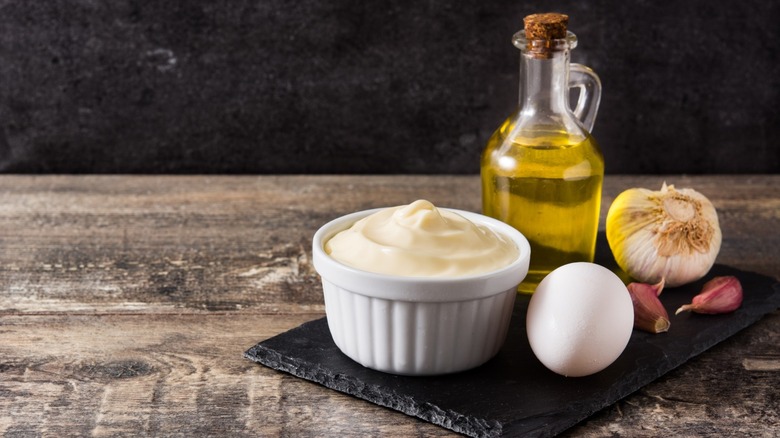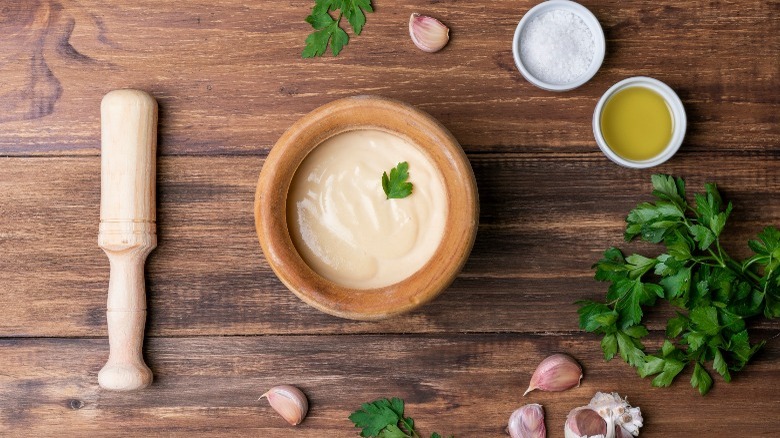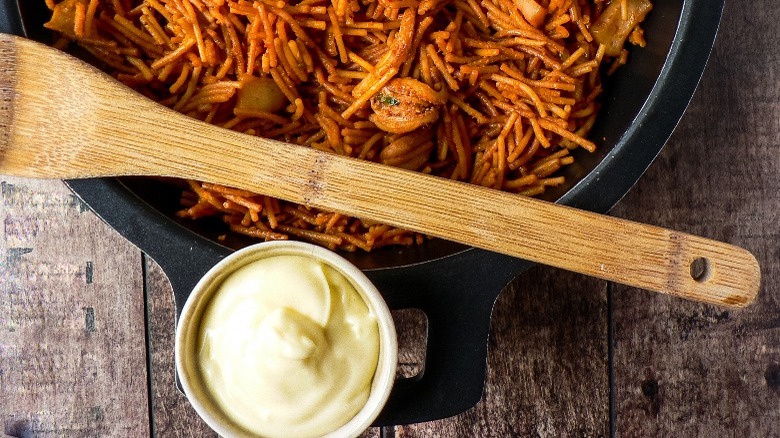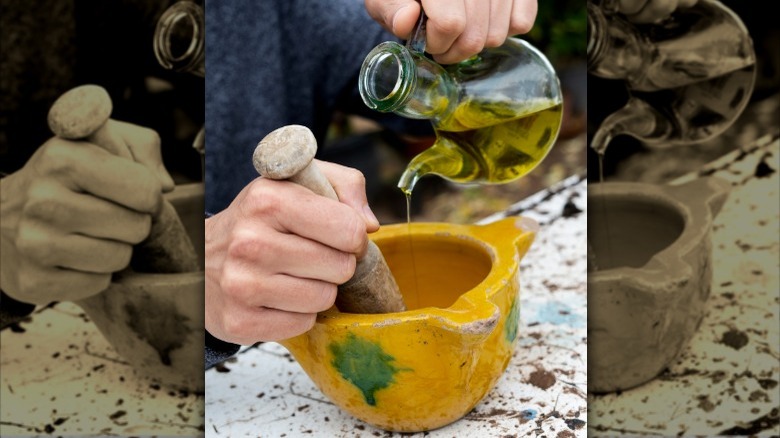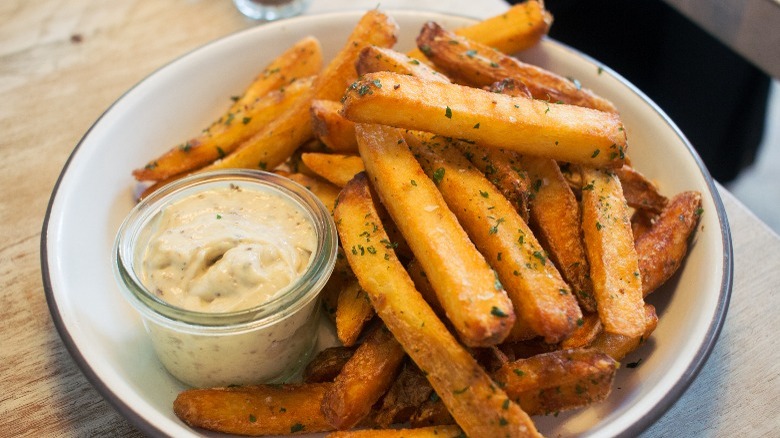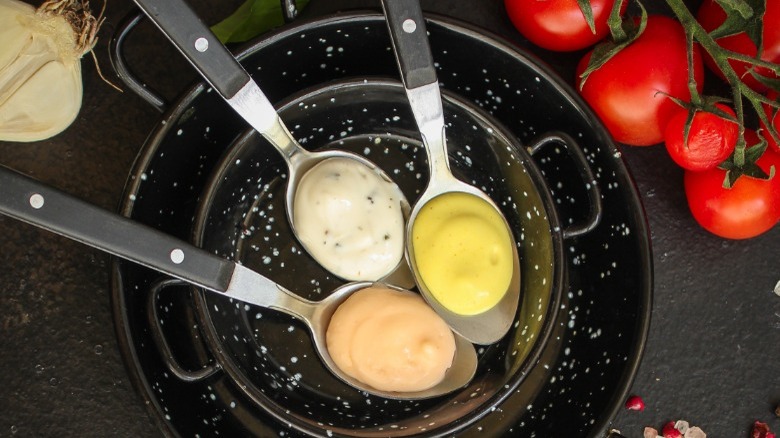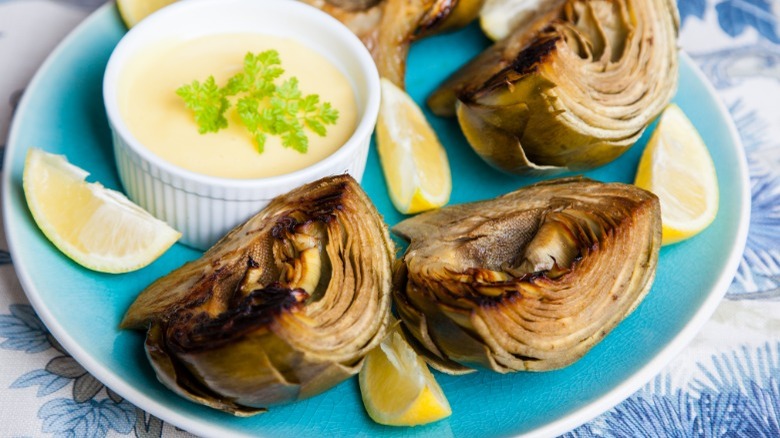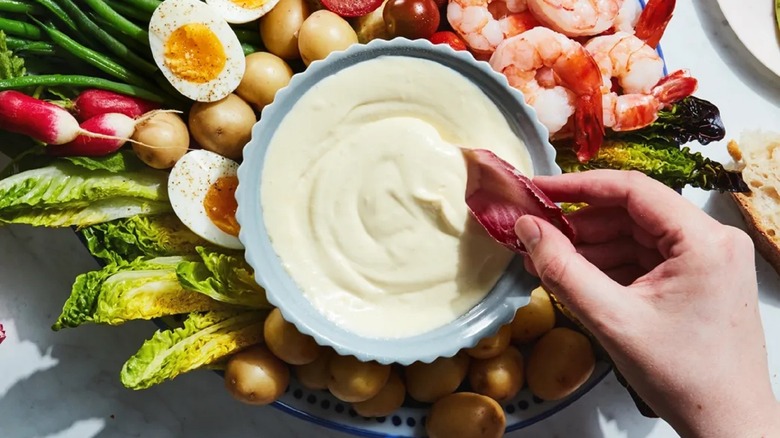Aioli: The Ancient Sauce That Makes Everything Taste Better
Aioli is one of those condiments that before you taste it, seems fairly unremarkable. Something akin to a dollop of mayo — it's thick, creamy, and vaguely white. Once you experience that first taste though, you quickly understand aioli's magic and why this sauce has been pleasing palates for centuries. And it's not just delicious on its own, it helps to amplify the flavors of just about everything it touches.
In French cooking there are five "mother sauces" famously described by Georges Auguste Escoffier in his "Le Guide Culinaire," (also known as "A Guide to Modern Cooking"). It is a widely held belief that mayonnaise is the sixth (via Saveur). These "mother sauces," provide the base of most, if not all sauces widely made today.
Starting with the fundamentals of one of these sauces allows you to riff on it by adding your own flavor and textural elements to create something new in a multitude of directions. In this regard, mayonnaise can be seen as the mother to such daughter sauces as tartar, rouille, remoulade, and of course, modern aioli.
But what exactly is aioli?
What is aioli?
Sometimes referred to as "fancy mayo" or "garlic mayonnaise," traditional aioli is so much more in terms of flavor — and less in terms of ingredients. While today's modern aioli can be adequately achieved by simply adding mashed-up garlic to homemade or store-bought mayo (even Bon Appétit recommends this shortcut) — if you want the real deal, you're going to need to simplify.
Historically, true aioli has been made by combining smashed fresh garlic cloves and flavorful olive oil, whipping them in a mortar and pestle until aerated, emulsified, silken, and fluffy. Through the years, aioli like this has been used to add and intensify flavors, or mask unpleasant ones on everything from meat, fish, and vegetables, to sandwiches, eggs, and more, according to The Food Timeline.
When added to fish stock, aioli luxuriously thickens one of Marseilles' most popular dishes (Bourride) before this decadent broth is then ladled into bowls over fish, shrimp, and/or potatoes and served alongside a toasted crusty baguette and more aioli.
A quick history of aioli
Though aioli's creamy garlicky origins have been traced to somewhere in the Mediterranean, there is some dispute as to where aioli first got its start, per Chefin. Its beginnings are often attributed to both Provence, France and Catalonia, Spain. Some food historians believe traditional aioli's roots are ancient Roman in origin and its name is thought to have been derived from the Latin word "aleatum," explains What's Cooking America.
It is posited that the Romans, who were notorious for using sauces to help cover up the foul flavors of food of "doubtful freshness," used aioli for this purpose. But according to Brittanica, the first historical mention of a sauce akin to aioli was made by Pliny the Elder, a Roman historian, who witnessed it being used in Catalonia, Spain, describing it as "garlic beaten up in oil and vinegar."
In Spain, it's been known as allioli, some say before it was ever known in France. In Lebanon, it's called toum and in Egypt, tooma, but regardless of its true origins, this divinely aerated emulsion has been a hit for centuries. Why? Because everything aioli touches just tastes better.
Should you buy it or make it?
While ready-made aioli (Kraft, Stone Hill, Heinz) can be found in your local grocery, you can make a quick and satisfying "cheater's aioli," starting with your favorite jarred mayo and adding crushed garlic and any other herbs you'd like to the mix. You can also make aioli from scratch, by first whipping up a batch of homemade mayonnaise, and then adding garlic and any other flavorings for a totally dreamy, customized-to-your-tastes, aioli experience.
All it takes to make aioli is a couple of high-quality fresh eggs, a ripe juicy lemon, salt, olive oil, and some fresh fragrant garlic. Rich and versatile, when it comes to aioli, this fat-luscious flavor enhancer is at its best when it's homemade. And while purists like popular YouTuber, Chef John of Food Wishes still rock the old-school mortar and pestle to make a more traditional aioli, most will tell you similar results can be achieved with an immersion blender and a lot less wear and tear on your arm.
Just keep in mind that you're making an emulsion of ingredients that don't normally mix well together (oil and lemon juice) and while that's not exceedingly hard, it does require a wee bit of patience. Try to power through your recipe too fast, adding in all the oil at once, and you'll end up with a soupy mess. But stick with it and just like mayonnaise, you'll find it pays to make aioli at home.
Why everything tastes better with aioli
Aioli becomes the carrier and champion of flavor. Whether it's the flavors you infuse or the food you put it on, the silken fattiness of modern aioli (which contains both oil and eggs) enhances the flavors of most everything it touches, allowing the tastes to linger longer. And because fat is such a necessary nutrient for human survival (due to its energy density), we end up feeling both full and satiated faster than lower-fat foods (via University of Chicago Medicine).
In addition, our tongues are equipped with fat-binding receptors that allow us to detect the presence of these fats and trigger mood-boosting neuropeptides and neurotransmitters like beta-endorphin and dopamine, according to a 2007 study in the Journal of Nutritional Science and Vitaminology.
Utah State University neurobiologist and researcher, Tim Gilbertson, (whose primary focus is on understanding the ways in which taste receptor cells function), believes that it's the fatty acids in polyunsaturated fats (like those contained in eggs, nuts, and fish like salmon) sending messages to the brain via an ion channel that affects the taste system's response. "The fats come in and block the ion channel which extends and heightens our response to the sweet or salty stimuli," says Gilbertson.
This means aioli, which contains unsaturated, polyunsaturated, and saturated fats (per Recipe of Health), may very well be perfectly primed to pump up flavors.
What's the difference between aioli, remoulade, rouille, and tartar?
All four of these sauces in their modern forms are derivatives or "daughters," of mother mayo. But it should be noted that aioli in its original form — is not a derivative of the creamy condiment. It's something else entirely (though still emulsified). Aioli's roots began sans egg and lemon. But the importance of adding egg to the emulsification process in aioli's current incarnation cannot be understated.
Without it, aioli's longevity and subsequent popularity may not have been the same. As Cook's Illustrated notes, the egg yolks, which contain lecithin, create a more stable emulsion than whipping alone. This important innovation made it quicker and more convenient to create the lush treat, putting it squarely in competition with its mayo-based sister sauces: rouille, remoulade, and tartar.
So, how do they differ? Rouille is a spicy, saffron-laden version of aioli, combining chili pepper, saffron, and garlic in a mayonnaise base, along with either bread or potatoes as a thickener (per New York Times). It's an essential part of French bouillabaisse and absolutely delicious spooned atop the chunks of crusty bread immersed in soup, waiting on the bottom of your bowl.
Remoulade continues the variation, adding ingredients like capers, pickles, hot sauces, vinegar, and more (via MasterClass). In France they add anchovy — in New Orleans, it's creole mustard and cayenne heat. Tartar sauce by comparison is much milder, adding only pickles and herbs and omitting the garlic.
Dietary restrictions: Can I eat aioli?
Aioli's short list of ingredients makes it easy for everyone from omnivores to pescatarians and vegetarians to figure out whether or not aioli is right for them, but there may still be one group with something to consider — vegans.
As most of us know, vegans do not consume animals or animal by-products, which means counting out modern aioli recipes made with eggs, but there are a lot of other ways for vegans to make and enjoy aioli, too. A quick online search will have you swimming in vegan aioli recipes that use everything from vegan mayonnaise, vegan yogurt, and an extra creamy version that subs in cashews, to soymilk, silken tofu, and even aquafaba versions.
Even so, nothing really beats the simplicity and garlic-packed flavor of true aioli made in the ancient tradition — sans eggs. But no matter your diet of choice, it's a sauce worth whipping up and drizzling on or dipping into when you want to amp up the flavor in your favorite foods.
Aïoli Garni
Besides being a great topper or dipper, aioli is also a wonderful celebratory dish on its own, called Aïoli Garni, which includes things like beef or boiled chicken, salt cod, and a variety of seasonal vegetables all served with a big bowl of aioli at its center (via YouTube). Also called Aioli Monstre or La Grand Aïoli as The New York Times Magazine reports, it is, "a dearly respected communal eating tradition in Provence," that historically coincided with the garlic harvest.
Aïoli Garni is often served on special occasions like Christmas Eve, though Charlie Hibbert of Ox Barn restaurant also enjoys it as a "Friday family feast." The British chef explains that this dish is a great way to showcase the best seasonal produce, fresh from the garden. Anina Belle Giannini of Le Chef's Wife notes that it can be served for any special occasion from patron saint days to Ash Wednesday — not just Christmas. In fact, Giannini featured the dish on her site for Bastille Day.
No matter how you choose to prepare and use your aioli, you can be sure you're carrying on its time-honored traditions of elevating the flavors of your next dish.
